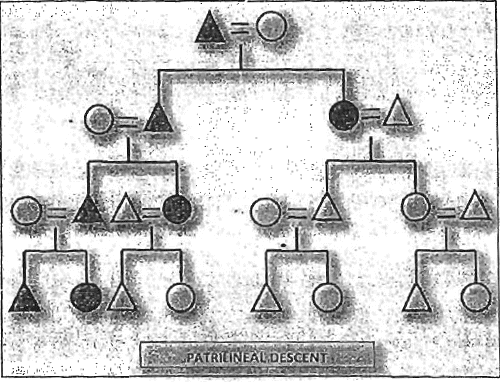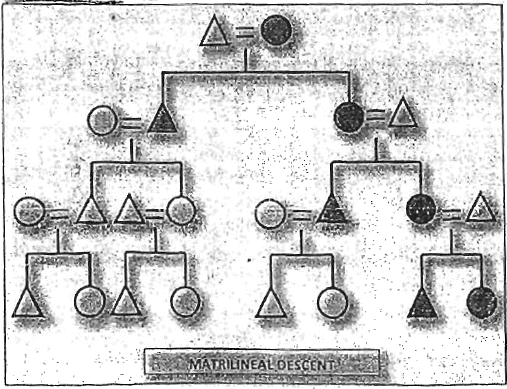Principles and Types of Descent | Anthropology Optional for UPSC PDF Download
Principles and Types of Descent
The rules governing kinship and relationships among the members of a given society are known as the rules of descent. They arise because many societies must deal with problems which cannot be handled by even the largest of the extended families. For example, it may be necessary for the members of one local group to be able to claim support and protection from individuals in another. Some ways to share rights in means of production, such as farm land, is also essential. By application of a rule of descent, sets of kin are identified such problems. Each individual can then trace a chain of parent-child links back to a common ancestor (who may be real or fictive) and by doing so, establish his place in a descent "group in which he has clearly defined rights and privileges. To operate most efficiently, membership" in a descent group ought to be clearly defined. Otherwise, the membership overlaps and it is not always clear where one’s primary loyalty belongs. The various principles of descent are discussed here.
Unilineal Descent
Unilineal descent is also called as the unisexual descent or unilateral descent. This rule establishes the kinship exclusively through male line or female line. The patrilineal or the agnatic descent recognizes the links through males and the matrilineal or the uterine descent recognizes the links through the females. The various sorts of unilineal descent groups ate the lineages and the clans.
In a lineage, the criterion of the membership is known. In such a descent group, the relationship between the individuals can be clearly demonstrable. In a clan the relationships between the individuals or the members of the descent group cannot be demonstrated and can only be assumed. The members of a lineage trace their descent to an ancestor who is known to have lived a number of generations back. In a clan, the members frequently trace their descent to an ancestor who is thought to have lived at some time in distant past, thus as greater genealogical distance. The clan sometimes claim symbolic association with a plant animal or an object called totems and this beliefs called as totemism. The lineages and their clans trace the descent to a common ancestor and hence are ancestor-focused groups.
Sometimes, the clans sub-divide over a period of time, with each segment still claiming descent from the original common ancestor. The several clans that make the claim of a common descent are together known as a phratry. Sometimes, the society as a whole may be sub-divided into two groups for the purpose of exchanging women through marriage. Each of these groups consists of a number of other larger groups, clans or phratries. These dual groups are called the moieties which are seen in the Miwok Indians of General California. In this society every lineage belongs to anyone of the two moieties - land or water. There are two different types o f Unilineal descent Patrilineal Descent and Matrilineal Descent, depending on the sex of the relative throughm whom descent is reckoned.
Patrilineal Descent
Patrilineal descent traces the ancestry through the male line. A patrilineage consists of a man (the founder), his sons and daughters, his son's sons and daughters his grandson's sons and daughters and so out Women such as the founder's daughters and the founder's sons' daughter and sons are the part of the patrilineage. But these women cannot pass on their rights and duties within their lineage to the offspring. These can be only through the males in the line. In patrilineal descent systems, relations of descent, authority and residence reinforces one another.
Amongst the Yoruba of West Nigeria the social order depends on the integration of political, economic and religious activities through systems of patrilineage called as the Idilies. The oldest male member of the group is acknowledged as the head of an idilie. He exercises religious and political authority over his lineage mates. The female members of the Idilies marry males from other Idilies and move to the communities of their husbands. Most male members live in single community with their wives. Members of other lineages may also live but in small numbers. But for all the practical purposes, political, economic and religious, a community is identified with its predominant idilie.
In the patrilineal societies, marriage is of considerable importance. The women who . are married into a patrilineage are important because they produce the heirs that allow the lineage to perpetuate. The patrilineages are exogamous. The females who are married into the patrilineages belong to their own patrilineage but not her children. Patrilineal societies are usually associated with patrilocal residence.
Segmentation As generations pass, the patrilineage expands. The patrilineage acquires so many members that it outgrows the resources available to it. When such a situation arises, the members seek alternative resources and move to other locations, and sometimes travel long distances. The patrilineage then subdivides. A patrilineage has equal chances of this kind of a sub-division after the death of a father who is the unifying factor, when the sons divide to head different sub-groups of their own. This sub-division of a clan or a lineage is called as segmentation. Large descent groups whether lineages or clans, are the candidates for segmentation.
Matrilineal Descent Matrilineal descent traces the -ancestry through the female .dine. A matrilineage consists of a woman founder her sons and daughters, her daughter's sons and daughters, her grand daughter’s sons and daughters etc. It is only through the founder's female line or the offspring, that till rights and; duties are passed on to the next generation . In the matrilineal descent the women must mate with the men from the other groups.
Although the inheritance rights are transferred through females, authority is vested in males in many instances giving brothers the control over their sister's children. The brothers provide competition to any relationship she may have with a husband, who is an outsider in her family. The crucial relations in a matrilineal society are between .the mother and daughter, brother and sister, mother's brother and sister's son. Consequently, the conjugal relationship is relatively unimportant and the matrilineage has little need for the social roles of a husband or a father. An important point to be noted is that the matrilineal and the patrilineal descent are not the opposites. In a patrilineage, the residence and the authority are combined within a descent group and in a matrilineage this patterning of relationship is seldom affected. The matrilineal organization does not mean a high status to the females within the matrilineage. As already noted, although the primary rights are passed through the female line, the authority is often vested in the males of the matrilineage. Problems arise as a result of this discrepancy of residence and descent on the one hand and the authority on the other. The matrilineages which are exogamous must establish relationships with men from outside in order to reproduce. But the rule of descent keeps the rights and duties out of the hands of the males marrying into, the group. In a matrilineal system then, men generally retain power and control within the lineage of their mother and sisters but the inheritance passes through their sister's sons.
Parallel Descent
Parallel descent is a possible form that is extremely rare. In such a type of a descent rule the males reckon their descent through the male line and the females reckon their descent through the female line. According to a majority of the anthropologists such a type of a descent can be possible but no instanced are provided by any society in the world.. Because of the latter reason they conclude that this descent system does not exist.
But in 1975Jane Safer, has reported this type of a descent rule among the Saha who live in Santra Marta Mountains near the Caribbean coast of Columbia close to the Venezuelan border. This being the only society that has been reported to have such a type of the descent principle, this type of a rule is not popular and widely talked about in anthropology.
|
209 videos|299 docs
|
















